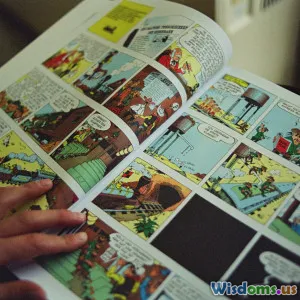
Can Revisiting Classic Genres Improve Box Office Success
9 min read Explore how revisiting classic film genres impacts box office performance with case studies, trends, and industry insights. (0 Reviews)
Can Revisiting Classic Genres Improve Box Office Success?
In an era dominated by blockbuster franchises, cinematic universes, and rapid content consumption, industry veterans and filmmakers are increasingly turning their gaze backwards—towards the enduring appeal of classic film genres. From Westerns and Film Noir to Sci-Fi and Romantic Comedies, these genres once defined cinematic eras. The question is: can revisiting these classic categories revitalize modern box office performance?
Exploring this question means unpacking the allure of nostalgia, genre evolution, and audience engagement. It is about understanding why certain stories and storytelling styles etched deeply into cultural fabric still carry weight, and how they can be leveraged in today's competitive film market.
The Timeless Allure of Classic Genres
Why Classic Genres Endure
Classic genres hold a unique place in film history, often characterized by specific narrative frameworks, stylistic conventions, and thematic concerns. Genres like Film Noir embody moral ambiguity and dark aesthetic shades, while the Western brings expansive landscapes and tales of rugged individualism. Their endurance stems from their ability to express universal human experiences—love, conflict, adventure—in recognizable formulas that comfort and thrill next generations.
Hollywood's Golden Age (1930-1960) produced many genres that became archetypes, influencing not just storytelling but also audience expectations. These genres endured because they presented both predictability in structure and variability in execution.
Nostalgia’s Role in Modern Cinema
Nostalgia is a powerful driver. Psychological studies (like those published in the Journal of Consumer Research) indicate that nostalgic consumption can create heightened emotional satisfaction, increased willingness to pay, and a stronger sense of connection.
Movies like "Star Wars: The Force Awakens" (2015) successfully revive the space opera genre, rooting the story in its classic antecedents while appealing to new audiences. These films demonstrate that stylistic and thematic cues rooted in classical genres can ignite emotional ties, driving box office sales.
Case Studies: Classic Genres in Contemporary Success
Revival of the Superhero Genre: Classic Comic Book Roots
While superhero films are often considered contemporary, their roots are deeply embedded in pulp and serial storytelling traditions of the early 20th century—themes and tropes that can be classified as classic genres. The success of Marvel’s Cinematic Universe, grossing over $28 billion worldwide as of 2023, is built on this foundation.
Revisiting classic tropes—heroes overcoming insurmountable odds, clear moral dichotomies, secret identities—helps reignite audience passion. Blending tradition with innovation has made superhero films significant box office juggernauts.
Neo-Westerns: A Genre Refined
Films like "No Country for Old Men" (2007) and "Hell or High Water" (2016) exemplify the resurgence of Western motifs in a modern cinematic language. While not traditional Westerns, they modernize frontier ethics and landscapes, blending with thriller elements.
This revival maintains core Western themes—lawlessness, survival, justice—repackaged with nuanced storytelling. Critics praised these films for revitalizing the genre, and their modest box office results confirmed audiences still crave these narrative frameworks.
Horror’s Cyclical Reinvention
Horror is arguably the most fertile ground for genre revisitations. Classic horror films like Hitchcock’s "Psycho" set the template for psychological dread, while the slasher and supernatural sub-genres equipped franchises like "Halloween" and "The Exorcist".
Recent successful revivals such as "It" (2017) and "A Quiet Place" (2018) employ classic horror elements—childhood fears, silence, claustrophobia—reimagined with contemporary technology and social concerns. The worldwide box office for horror exceeds $1 billion regularly, demonstrating that revisiting core genre elements coupled with modern twists can be widely profitable.
Market Dynamics and Audience Psychology
The Appetite for Familiarity and Innovation
Modern audiences simultaneously desire both the comfort of familiar storytelling and novel experiences. Revisiting classic genres can satisfy the first, acting as an anchor, while new technology, perspectives, and storytelling methods provide innovation.
This balance explains the success of films like "Blade Runner 2049" (2017), which revisits the seminal cyberpunk sci-fi but adds depth with 21st-century cinematic tools and philosophical inquiry, grossing over $260 million globally.
Risk Mitigation for Studios
Studios view established genres with recognizable patterns as lower-risk investments. Production companies often analyze historical box office data; classic genres come with proven demand curves, providing better forecasting capability.
Moreover, marketing these films benefits from genre brand recognition. For instance, targeting fans of classic crime dramas with a modern gangster film helps precisely define the audience segment, optimizing advertising.
Challenges and Pitfalls of Revisiting Classic Genres
Overreliance and Audience Fatigue
A crucial pitfall resides in repetitive exploitation of nostalgic elements leading to stale, uninspired productions. The underperformance of some remakes, such as "Ben-Hur" (2016), underscores that mere genre revival without creative reinvention often fails to engage contemporary audiences.
Cultural and Contextual Shifts
Classic genre conventions may contain outdated social constructs. Filmmakers must rethink these around modern values to avoid alienating audiences—in terms of representation, gender roles, and inclusion.
The 2017 remake of "Ghost in the Shell" was met with criticism for casting choices that did not reflect evolving cultural sensitivities, leading to both reputational and financial impacts.
Strategies for Effective Genre Revisit
Fusion of Genres
Instead of pure revival, blending classic genres with modern styles can invigorate storytelling. For example, "Get Out" combines horror and social satire to provide a fresh perspective.
Technological Enhancement
Utilizing advancements in CGI, IMAX filming, and sound design enables a richer sensory experience. Classic genres adapt to today’s heightened expectations while retaining core appeal.
Narrative Innovation Within the Framework
Subverting genre tropes or deepening character complexity can make classic genres resonant. Films like "Logan" bring mature themes and emotional subtlety to superhero archetypes.
Conclusion: Nostalgia as Both Canvas and Catalyst
Revisiting classic film genres presents a compelling opportunity for box office success—rooted not just in nostalgia but in a strategic synthesis of tradition with contemporary artistry. When filmmakers and studios thoughtfully reimagine these genres, respecting the original spirit while innovating context, the results can unlock renewed audience enthusiasm, cross-generational appeal, and lucrative market performance.
The ultimate takeaway: Classic genres are not relics to be replicated verbatim but dynamic frameworks inviting fresh interpretation. Harnessed wisely, they are powerful tools not only honoring cinematic heritage but also shaping future entertainment landscapes.
References and Further Reading:
- Journal of Consumer Research: The Power of Nostalgia in Consumer Behavior
- Box Office Mojo: Superhero box office statistics
- Film Quarterly: The Neo-Western Revival
- Variety: The Market Viability of Horror Films
A careful balance between homage and innovation can turn classic genres into box office goldmines, reconnecting audiences to timeless stories while addressing today's sensibilities and expectations.
Rate the Post
User Reviews
Popular Posts



















